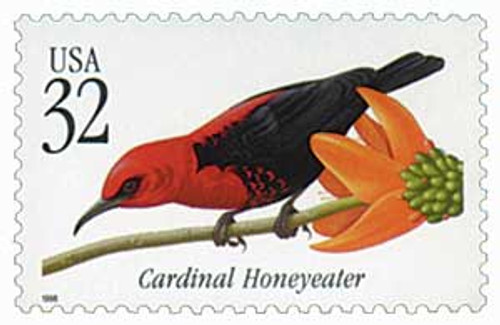
1998 32c Antillean Euphonia Tropical Bird
# 3222 - 1998 32c Antillean Euphonia Tropical Bird
$1.00 - $3.20
U.S. #3222
1998 32¢ Antillean Euphonia
Tropical Birds
1998 32¢ Antillean Euphonia
Tropical Birds
Issue Date: July 29, 1998
City: Ponce, Puerto Rico
Quantity: 17,500,000
Printed By: Banknote Corporation of America
Printing Method: Lithographed
Perforations: 11.2
Color: Multicolored
City: Ponce, Puerto Rico
Quantity: 17,500,000
Printed By: Banknote Corporation of America
Printing Method: Lithographed
Perforations: 11.2
Color: Multicolored
This issue is part of a four-stamp se-tenant featuring tropical birds that are native to the islands belonging to the United States. The Antillean Euphonia resides in the thick mountain forests of Puerto Rico. The Green-throated Carib is also found in Puerto Rico, but along the northeast coast. The Crested Honeycreeper is an endangered species from the rain forests of Maui, and the Cardinal Honeyeater lives on the South Pacific island of Samoa.
The antillean euphonia makes its home in tropical Puerto Rico. Because the bird lives in the thick mountain forests of Luquillo, it is very rarely seen by humans. It is a member of the species Thraupinae.
Euphonias are small, colorful birds. Males are mostly black in color, with some violet, blue, or green on the upper parts and throat. The forehead and other spots on the bird’s underside are bright yellow. Female euphonias, less brilliantly colored than the males, are usually dull green and yellow. Euphonias build covered nests, with an opening in the side, in trees and bushes. Sometimes they make nests in tunnels in the ground.
Eggs are incubated by the females alone, and they usually lay four or five at one time. The babies hatch within 12 to 14 days, and are fed regurgitated food by both the male and female. Babies remain in the nest for 17 to 24 days, and both parents take special care in keeping the nest clean. It takes about one year for the young to acquire adult plumage.
Euphonias have poorly developed voices and aren’t good singers because they are weak territorial defenders. The birds’ bills and tongues allow them to easily draw nectar from flowers, and they also feed on fruits produced by trees.
U.S. #3222
1998 32¢ Antillean Euphonia
Tropical Birds
1998 32¢ Antillean Euphonia
Tropical Birds
Issue Date: July 29, 1998
City: Ponce, Puerto Rico
Quantity: 17,500,000
Printed By: Banknote Corporation of America
Printing Method: Lithographed
Perforations: 11.2
Color: Multicolored
City: Ponce, Puerto Rico
Quantity: 17,500,000
Printed By: Banknote Corporation of America
Printing Method: Lithographed
Perforations: 11.2
Color: Multicolored
This issue is part of a four-stamp se-tenant featuring tropical birds that are native to the islands belonging to the United States. The Antillean Euphonia resides in the thick mountain forests of Puerto Rico. The Green-throated Carib is also found in Puerto Rico, but along the northeast coast. The Crested Honeycreeper is an endangered species from the rain forests of Maui, and the Cardinal Honeyeater lives on the South Pacific island of Samoa.
The antillean euphonia makes its home in tropical Puerto Rico. Because the bird lives in the thick mountain forests of Luquillo, it is very rarely seen by humans. It is a member of the species Thraupinae.
Euphonias are small, colorful birds. Males are mostly black in color, with some violet, blue, or green on the upper parts and throat. The forehead and other spots on the bird’s underside are bright yellow. Female euphonias, less brilliantly colored than the males, are usually dull green and yellow. Euphonias build covered nests, with an opening in the side, in trees and bushes. Sometimes they make nests in tunnels in the ground.
Eggs are incubated by the females alone, and they usually lay four or five at one time. The babies hatch within 12 to 14 days, and are fed regurgitated food by both the male and female. Babies remain in the nest for 17 to 24 days, and both parents take special care in keeping the nest clean. It takes about one year for the young to acquire adult plumage.
Euphonias have poorly developed voices and aren’t good singers because they are weak territorial defenders. The birds’ bills and tongues allow them to easily draw nectar from flowers, and they also feed on fruits produced by trees.












